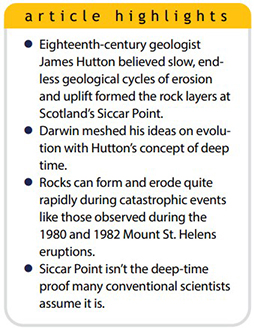 Rowing in a boat off the east coast of Scotland, geologist Dr. James Hutton told the boat pilot to pull ashore.1 Before his gleeful eyes was the “proof” of an old earth he was seeking. Rising from the sea at Siccar Point were two types of rocks stacked one on the other. On the bottom was a severely tilted, gray, shale-rich rock called primary micaceous schistus, now identified as Silurian greywacke (gray-wack-ee). Above were flatter red sediments known as the secondary sandstone strata, today called the Devonian Upper Old Red Sandstone.1 On that momentous day in June 1788, the three prominent Scottish academics in the boat—Hutton, geologist Sir James Hall, and geologist and mathematician John Playfair—believed they were staring into “the abyss of time.”2
Rowing in a boat off the east coast of Scotland, geologist Dr. James Hutton told the boat pilot to pull ashore.1 Before his gleeful eyes was the “proof” of an old earth he was seeking. Rising from the sea at Siccar Point were two types of rocks stacked one on the other. On the bottom was a severely tilted, gray, shale-rich rock called primary micaceous schistus, now identified as Silurian greywacke (gray-wack-ee). Above were flatter red sediments known as the secondary sandstone strata, today called the Devonian Upper Old Red Sandstone.1 On that momentous day in June 1788, the three prominent Scottish academics in the boat—Hutton, geologist Sir James Hall, and geologist and mathematician John Playfair—believed they were staring into “the abyss of time.”2
Prior to this moment, most learned people accepted the biblical 6,000-year-old age of the earth. But Hutton was convinced that Earth was immensely old. He didn’t accept that catastrophes played a role in Earth’s history, and especially denied a universal flood.1 Instead, he believed that new lands rose from below, driven by the heat of the earth’s interior. Following uplift, erosion would slowly wear the landmass down until new forces again pushed up more land. Hutton saw this endless cycle of uplift and erosion as requiring eons of time. He argued that modern rates of erosion were too slow and necessitated vast amounts of time, much more than the Bible’s chronology allowed.

From these musings, Hutton’s philosophy of uniformitarianism was born.3 He wrote at the end of the 1788 edition of his Theory of the Earth, “The result, therefore, of our present enquiry, is that we find no vestige of a beginning, no prospect of an end.”4 The 1788 discovery at Siccar Point wasn’t the first time Hutton suggested the earth was ancient. He had given a series of lectures in 1785 outlining his rationale for an earth age far beyond 6,000 years, but Siccar Point was the single exposure of rocks that gave plausibility to his theorized endless cycles of uplift and erosion.1
What is seemingly so convincing about Siccar Point that old earth scientists consider it a “shrine”?2 Starting from the bottom, we see a sequence of rocks (the greywacke) that was deposited and then later tilted, eroded, and followed by deposition of another sequence of rocks on top (the Old Red Sandstone). But this series of events doesn’t require cycles of uplift and erosion over vast amounts of time. Mount St. Helens has shown that deposition and erosion can occur rapidly and completely alter a landscape in a matter of hours or days.5
Hutton never witnessed such a cataclysmic event. Instead, his uniformitarian views have been entrenched in conventional scientific thought all the way to the present. Siccar Point also had a profound influence on geologist Charles Lyell, who visited the site in 1824.2 He popularized Hutton’s uniformitarianism and deep time in his 1830 book Principles of Geology. A young Charles Darwin read this book and readily accepted the uniformitarian paradigm. In fact, evolution couldn’t have been conceived without being cloaked in the shroud of deep time.
Siccar Point remains a bastion of uniformitarianism and is still used to indoctrinate young minds in the falsehood of deep time. Ironically, the rocks themselves don’t attest to formation over eons. Catastrophes like Mount St. Helens have demonstrated that similar rocks can form fast and erode quickly. Siccar Point is best explained as an example of rapid deposition and erosion during the global Flood just 4,500 years ago.6
References
- Repcheck, J. 2009. The Man Who Found Time: James Hut ton and the Discovery of Earth’s Antiquity. New York: Basic Books.
- Kerr, A. 2018. Classic Rock Tours 1. Hutton’s Unconformity at Siccar Point, Scotland: A Guide for Visiting the Shrine on the Abyss of Time. Geoscience Canada. 45 (1): 27-42.
- Cambridge’s William Whewell coined the term uniformi tarianism in 1832. Even though James Hutton didn’t invent the word, it aptly describes his philosophy of geology and deep time. He believed geologic processes were uniformly slow over vast amounts of time and excluded most types of catastrophes as the source of geological formations.
- Hutton, J. 1788. Theory of the earth. Transactions of the Royal Society of Edinburgh. 1: 304.
- Clarey, T. and F. Sherwin. 2020. Mount St. Helens, Living Laboratory for 40 Years. Acts & Facts. 49 (5): 10-13.
- Clarey, T. 2020. Carved in Stone: Geological Evidence of the Worldwide Flood. Dallas, TX: Institute for Creation Research, 266-267.
* Dr. Clarey is Director of Research at the Institute for Creation Research and earned his Ph.D. in geology from Western Michigan University.



